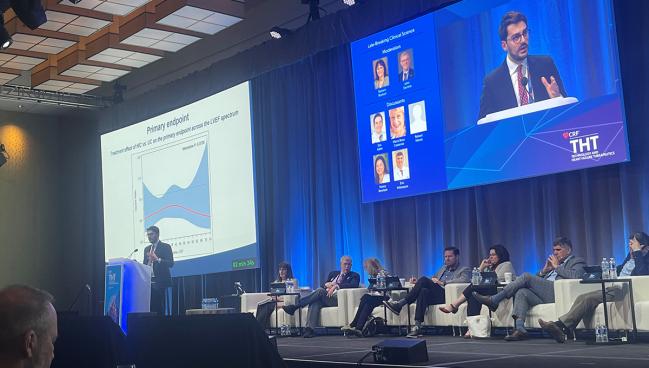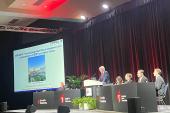High-Intensity Care After Acute HF Pays Off Across LVEF Spectrum: STRONG-HF
The trial has challenged physicians to do even better in treating patients after a heart failure admission, Amanda Vest says.

BOSTON, MA—The benefits of close follow-up and rapid uptitration of medications after an acute heart failure (HF) hospitalization apply to patients across the range of left ventricular ejection fraction, according to an analysis of the STRONG-HF trial.
Compared with usual care, the high-intensity intervention reduced the rate of all-cause death or rehospitalization for HF at 180 days (primary endpoint) and improved quality of life, with no significant interactions between the treatment effects and LVEF (P = NS for interactions), Matteo Pagnesi, MD (University of Brescia, Italy), reported here at the Technology and Heart Failure Therapeutics (THT) 2023 meeting.
“Therefore, this strategy, the high-intensity-care strategy, may be beneficial . . . in acute heart failure across the entire LVEF spectrum—and so in patients with reduced, mildly reduced, or even preserved ejection fraction,” he concluded.
Amanda Vest, MBBS (Tufts Medical Center, Boston, MA), told TCTMD she was a little surprised to see that the results of intensive management were as good, or perhaps even slightly better, in patients with an LVEF of 40% or greater than in those with reduced ejection fraction. That’s because evidence and recommendations supporting use of the three medication classes targeted in the study—renin-angiotensin system (RAS) inhibitors, beta-blockers, and mineralocorticoid receptor antagonists (MRAs)—are much stronger in patients who have heart failure with reduced ejection fraction (HFrEF) than in those with preserved ejection fraction (HFpEF). For beta-blockers in particular, she added, there are studies indicating that they don’t help in HFpEF, and might even be harmful.
That raises the question, then, of how much of the impact of high-intensity care in STRONG-HF is due to uptitration of the medications versus the closer follow-up of patients in the vulnerable period after hospitalization.
“It’s either those more-frequent touches with a clinician and greater intensity of the overall care, or it’s something synergistic about the three groups of medicines that are being uptitrated that are showing us something that didn’t exist when the medication groups were trialed separately,” Vest said, adding that the more likely choice is the increased intensity of clinical care providing better patient support and closer monitoring.
During a panel discussion following his presentation, Pagnesi said it was probably a combination of the two: “We need to try to implement therapy, but we can do this only if it is safe, so only if we can visit our patients and test NT-proBNP and test the labs.”
Exploring the Impact of LVEF
STRONG-HF randomized 1,078 patients recently hospitalized for acute heart failure to usual care or high-intensity care, which involved rapid uptitration of ACE inhibitors/ARBs/ angiotensin receptor-neprilysin inhibitors (ARNIs), beta-blockers, and MRAs within the first 2 weeks accompanied by several safety visits over the first 6 weeks. Importantly, there were no inclusion/exclusion restrictions based on LVEF.
The medications targeted in the trial are neurohormonal modulators, and their use is mainly supported by evidence in patients with HFrEF. Pagnesi noted, however, that neurohormonal activation is present in patients with acute heart failure irrespective of LVEF, and thus, these drugs might be beneficial across the range of ejection fractions.
The look at the results of STRONG-HF stratified by LVEF, with a cut point of 40%, was prespecified according to the main primary and secondary outcomes, Pagnesi said, and all other analyses are post hoc.
In general, patients with an LVEF of 40% or greater were older than those with an LVEF below 40%; were less frequently men; were more likely to have diabetes, a history of HF, or a primary ischemic HF etiology; and had lower NT-proBNP and higher systolic blood pressure.
The high-intensity intervention led to uptitration of the three drug classes regardless of LVEF, Pagnesi reported.
For the primary endpoint of all-cause death or HF rehospitalization at 180 days, the benefit of intensive management was not significantly different between the two LVEF subgroups (P = 0.2291 for interaction). There was a hint, however, of a greater treatment effect in those with an LVEF above the cut point (HR 0.44 vs 0.70).
When looking at LVEF as a continuous variable, there still was no impact on the treatment effects (P = 0.3720 for interaction).
In the overall trial, high-intensity care also improved quality of life according to the EQ-5D visual analog scale at 90 days, and this, too, was unaffected by LVEF as a continuous variable (P = 0.3579 for interaction).
LVEF also did not influence the safety of the intervention, Pagnesi said.
Asked about the implications of STRONG-HF, including this LVEF analysis, Vest said, “At many institutions, the results have challenged us to look again at our postdischarge patient pathways and aim for even better than what we’re doing. It’s nice to have the STRONG-HF primary results to fall back on when we’re having conversations with payers, with our hospital administration, and indeed with our patients themselves about why it’s important to aim for an intensive period of follow-up in that high-risk zone after a hospitalization.
“Change can sometimes take a little while in hospital systems,” she continued, “but it has certainly given us way more to think about, new standards of care to aspire to, and more confidence that we’re doing the right thing when we try to increase the intensity of the postdischarge phase of care for patients with heart failure.”
Moving forward, Vest said, it would be interesting to see whether a similar high-intensity intervention targeting patients with HFpEF and incorporating sodium-glucose cotransporter 2 (SGLT2) inhibitors, which were not included in STRONG-HF, could have even greater benefits than those observed here.
Todd Neale is the Associate News Editor for TCTMD and a Senior Medical Journalist. He got his start in journalism at …
Read Full BioSources
Pagnesi M. Left ventricular ejection fraction and intensive up-titration of oral treatment in patients recently hospitalized for heart failure: insights from the STRONG-HF trial. Presented at: THT 2023. March 21, 2023. Boston, MA.
Disclosures
- Pagnesi reports personal fees from Abbott Vascular, AstraZeneca, Boehringer Ingelheim, and Vifor Pharma.





Comments